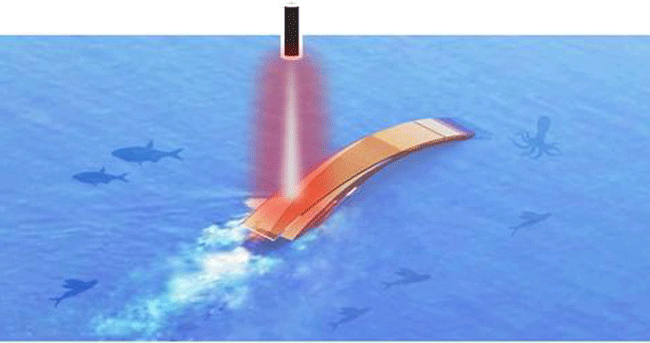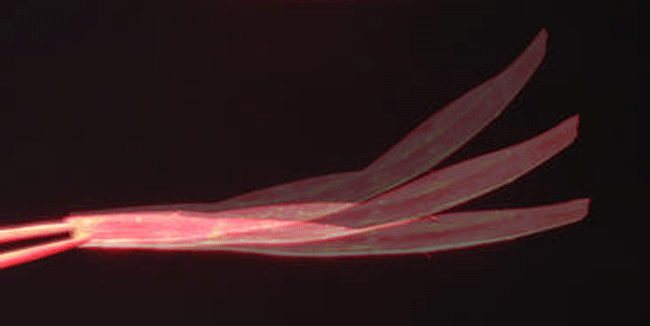[미국] UC 리버사이드, 물 속 오염물질 제거하는 필름 개발
UC 리버사이드(UC Riverside)가 개발한 소프트로봇 ‘Neusbot’은 바다로 유출된 기름을 처리하거나 식수 속 오염물질을 제거하도록 설계됐다.
필름형태로 구성된 이 로봇은 빛과 물을 연료로 구동되며 사람의 손길이 닿기 어려운 외딴 지역을 청소하기 위해 무기한으로 배포될 수 있다.

연구를 진행한 지웨이 리(Zhiwei Li) 박사는 “소프트 로봇을 지속가능하게 만들고 환경 변화에 스스로 적응할 수 있도록 하는 것”이라고 연구목적을 밝히며 “태양광이 전력으로 사용된다면 이 기계는 지속가능하며 추가 에너지원이 필요하지 않을 것”이라고 설명했다.
UC 리버사이드에 따르면 Neusbot은 빛반응에 의해 모양이 변하지 않아, 원하는 위치와 시간에 작동가능하다는 것이다. Neusbot는 전원으로 사용하는 것을 제외하고 필름의 중간층은 다공성이며 물뿐만 아니라 산화철과 구리 나노막대를 보유하고 있으며 나노로드는 빛 에너지를 열로 변환해 물을 기화시키고 물표면을 가로질러 펄스 운동에 전력을 공급하도록 설계됐다.

한편 연구진의 이번 기술은 세계적인 국제학술지 사이언스 로보틱스(Science Robotics)에 게재됐다.
현재 버전의 Neusbot에는 3개의 레이어를 바탕으로 향후 기타 화학물질을 흡수할 수 있는 실험을 준비 중이다.
[원문보기]
Light-powered soft robots could suck up oil spills
Water striders, steam engines inspire slicker picker-upper
Afloating, robotic film designed at UC Riverside could be trained to hoover oil spills at sea or remove contaminants from drinking water.
Powered by light and fueled by water, the film could be deployed indefinitely to clean remote areas where recharging by other means would prove difficult.
“Our motivation was to make soft robots sustainable and able to adapt on their own to changes in the environment. If sunlight is used for power, this machine is sustainable, and won’t require additional energy sources,” said UCR chemist Zhiwei Li. “The film is also re-usable.”
Researchers dubbed the film Neusbot after neustons, a category of animals that includes water striders. These insects traverse the surface of lakes and slow-moving streams with a pulsing motion, much like scientists have been able to achieve with the Neusbot, which can move on any body of water.
While other scientists have created films that bend in response to light, they have not been able to generate the adjustable, mechanical oscillation of which Neusbot is capable. This type of motion is key to controlling the robot and getting it to function where and when you want.
Technical details of this achievement are described in a new Science Robotics paper.
“There aren’t many methods to achieve this controllable movement using light. We solved the problem with a tri-layer film that behaves like a steam engine,” Li explained.
The steam from boiling water powered the motion of early trains. It is a similar principle that powers Neusbot, except with light as the power source. The middle layer of the film is porous, holding water as well as iron oxide and copper nanorods. The nanorods convert light energy into heat, vaporizing the water and powering pulsed motion across the water’s surface.
Neusbot’s bottom layer is hydrophobic, so even if an ocean wave overpowered the film, it would float back to the surface. Additionally, the nanomaterials can withstand high salt concentrations without damage. “I’m confident about their stability in high salt situations,” Li said.
Li and UCR chemistry professor Yadong Yin specialize in making robots from nanomaterials. They controlled Neusbot’s direction by changing the angle of its light source. Powered only by the sun, the robot would simply move forward. With an additional light source, they could control where Neusbot swims and cleans.
The current version of Neusbot only features three layers. The research team wants to test future versions with a fourth layer that could absorb oil, or one that absorbs other chemicals.
“Normally, people send ships to the scene of an oil spill to clean by hand. Neusbot could do this work like a robot vacuum, but on the water’s surface,” Li said.
They would also like to try and control its oscillation mode more precisely and give it the capability for even more complex motion.
“We want to demonstrate these robots can do many things that previous versions have not achieved,” he said.
[출처 = UC Riverside(https://news.ucr.edu/articles/2021/12/02/light-powered-soft-robots-could-suck-oil-spills) /2021년 12월 2일자 보도자료]

